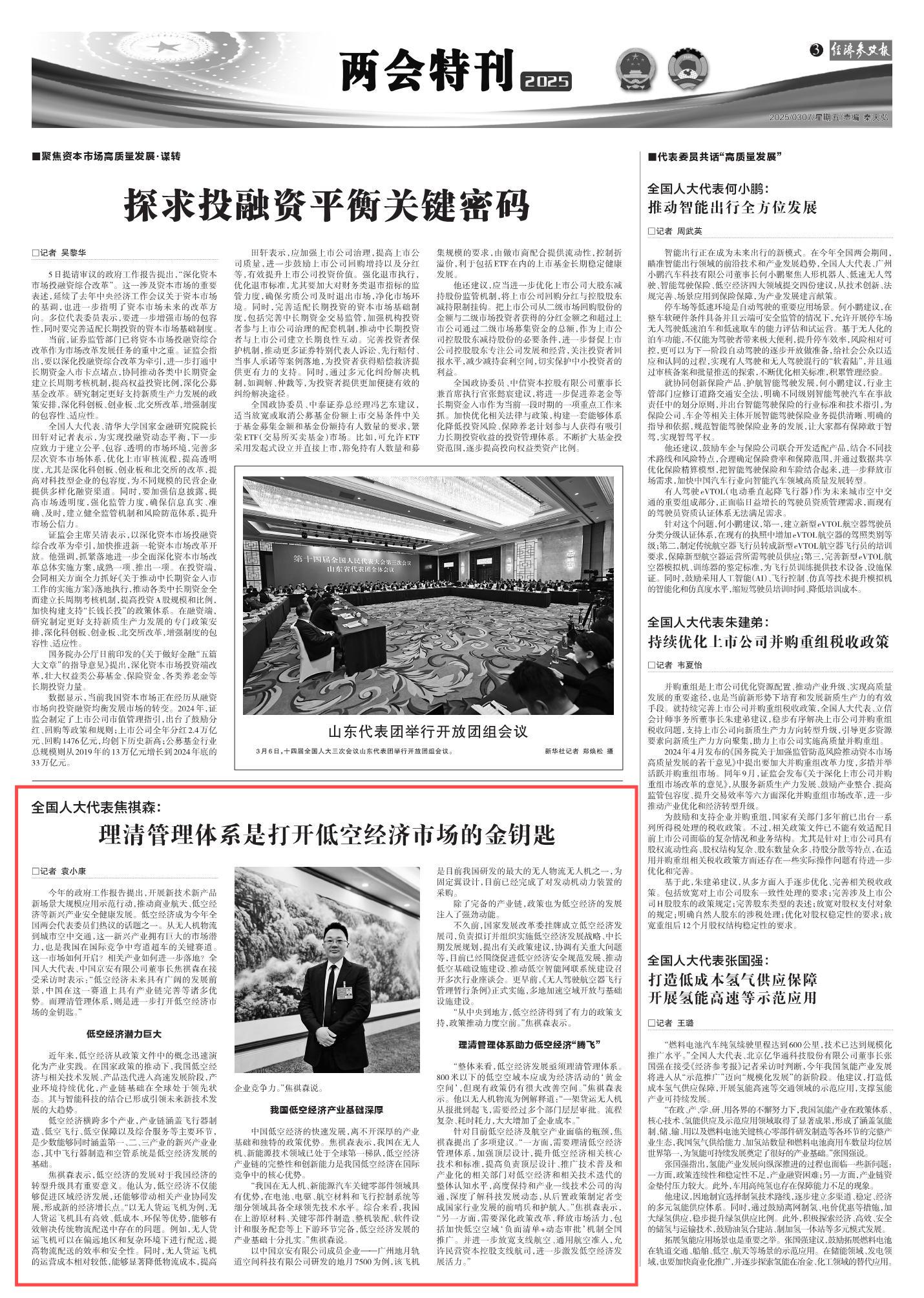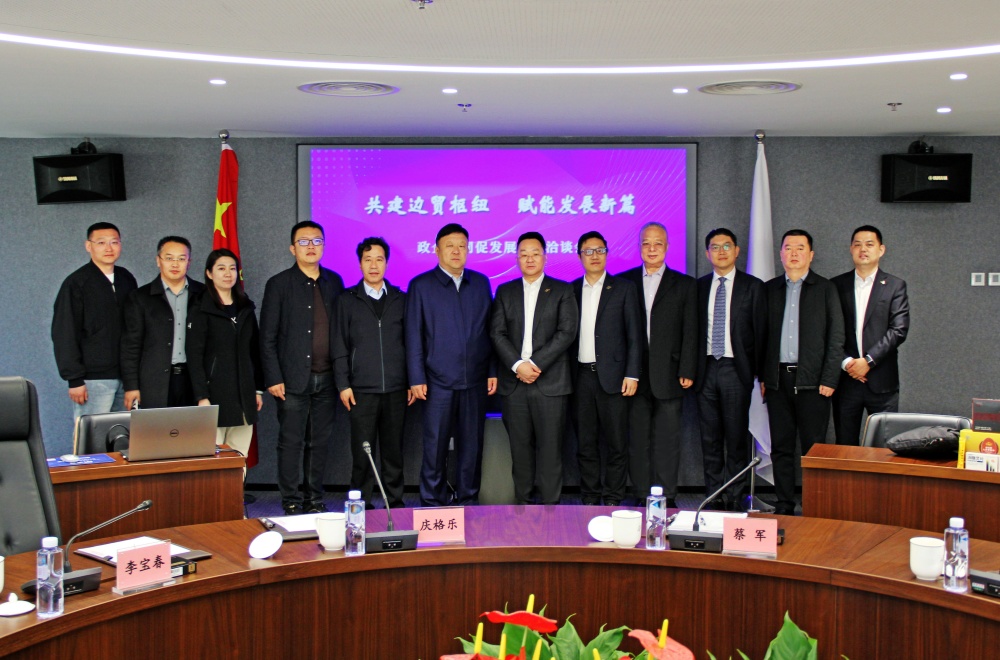

On March 7, proposals from Jiao Qisen, National People’s Congress (NPC) Deputy and Chairman of China Jing An Limited, on low-altitude economy development were prominently featured in the Economic Information Daily’s Two Sessions special edition. This reflects the integration of entrepreneurial wisdom into the nation’s top-level development narrative and its official entry into the core channel of the national mainstream public opinion field. This recognition not only signifies a high degree of the deputy’s ability to participate in politics and deliberate state affairs but also serves as an authoritative certification of his dedication to fulfilling his duties. This is a vivid reflection of the dual mission of entrepreneurs in the new era: "contributing strategies to the country and voicing concerns for the people."
Economic Information Daily 2025/03/07 Friday | Issue No. 12989 | Two Sessions Special Edition

Full Text of the Newspaper Article:
This year’s Government Work Report proposes agendas including launching large-scale demonstration for the application of new technologies, products, and scenarios; aiming to promote the safe and healthy development of emerging industries such as commercial aerospace and low-altitude economy. The low-altitude economy has become one of the heated agendas discussed by deputies and members during this year’s Two Sessions. From UAV logistics to urban air mobility, this emerging industry holds enormous market potentials and represents a critical track for China to achieve technologically leading in the global market. . How can this market be unlocked? How can related industries be further implemented?
Jiao Qisen, NPC Deputy and Chairman of China Jing An, stated in an interview: "The low-altitude economy has broad development prospects, and China possesses significant advantages such as a complete industrial chain in this field. Raveling out the management system is the key to further unlocking the low-altitude economy market."
Huge Potential of the Low-Altitude Economy
In recent years, the low-altitude economy has rapidly transitioned from a policy formulation to industrial practice. Driven by national policies, China’s low-altitude economy and related technological development as well as product iteration have entered a stage of rapid growth. The development environment of low-altitude economy continues to optimize and its related industrial chain maintains a globally leading position. Its integration with intelligent technology has formed a major trend which is poised to guide future development of emerging technologies.
The low-altitude economy spans multiple industries including aircraft manufacturing, low-altitude flight, low-altitude support, comprehensive services, and other major parts of the industrial chain. It is one of the few emerging industrial formats that can simultaneously cover primary, secondary, and tertiary industries. Aircraft manufacturing and air traffic control systems are the foundation for its development.

Jiao Qisen, National People’s Congress Deputy and Chairman of China Jing An Limited
Contribution to Economic Transformation
Jiao Qisen emphasized that the development of the low-altitude economy holds significant importance for China’s economic transformation and upgrading. He believes that it can not only promote regional economic development but also drive collaborative development of related industries which therefore creates new economic growth points.
"Take unmanned cargo aircraft as an example. Unmanned cargo aircraft offers advantages such as high efficiency, low cost, and environmental friendliness, which effectively provides possible solutions to the challenges inherent in traditional logistics distribution. For instance, they enable delivering goods in remote areas and complex environments, significantly enhancing efficiency and safety. Additionally, the relatively low operating costs can significantly reduce logistics expenses and enhance enterprise competitiveness," Jiao said.
Solid Industrial Foundations in China
The rapid development of the low-altitude economy in China benefits from its profound industrial foundations and distinctive policy advantages. Jiao noted that China has positioned itself in the global first-tier in UAVs and new energy technology sector The completeness and innovation capabilities of low-altitude economy industrial chain constitute China’s core advantages in global competition.
"China leads globally in UAVs and key components for new energy vehicles, boasting advanced technologies in battery, electric drive, aviation materials, and flight control systems. Generally, , China has a complete upstream and downstream industrial chain, including raw materials, key component manufacturing, final assembly, software design, and service support, which provides a solid foundation for low-altitude economy development," Jiao stated.
An example is the Diyue 7500, developed by Guangzhou Diyue Orbital Space Technology Co., Ltd., a member enterprise of China Jing'an. As one of China’s largest unmanned logistics UAVs with a fixed-wing design, it has completed the procurement of engine power units.
Policy Momentum
In addition to a complete industrial chain, policies have injected robust momentum into the low-altitude economy’s development.
Recently, the National Development and Reform Commission established the Low-Altitude Economy Development Department, which is responsible for formulating and implementing low-altitude economy development strategies, medium- and long-term plans, and coordinating other major issues. The department has held multiple industry symposiums which addresses the following agendas: promoting safe and standardized low-altitude economy development, advancing infrastructure construction, and driving the development of low-altitude intelligent networking systems. Earlier, The Interim Regulations on the Flight Management of Unmanned Aerial Vehicles was officially implemented. It has prompted multiple regions to accelerate airspace opening and infrastructure construction.
"From the central to local governments, the low-altitude economy has received strong and unprecedented policy support", Jiao said.
Streamlining the Management System
"Overall, the low-altitude economy urgently needs to raveling out its management system. The airspace below 800 meters should become a ‘golden space’ for economic activities, but existing policies still have significant room for improvement," Jiao noted. He took UAV logistics as an example: "Authorizing a cargo UAV flight takeoff requires coordination across multiple departments and entails complex procedures. The long procedures and time cost highly increase the enterprise costs. In response to the possible challenges that low-altitude economy and aviation industry face, Jiao proposed several recommendations:
1. Strengthen top-level design for the low-altitude economy management system, enhance core technologies and standards, and improve the overall understanding of low-altitude economy and technological iterations among departments responsible for top-level design, technology promotion, and industrialization. Maintain close communication with front-line technology companies to deeply understand technological trends which makes a transformation from post-hoc policy-makers to proactive pioneers and guardians of industry development.
2. Deepen policy reforms to unleash market vitality, including accelerating the nationwide promotion of a "negative list + dynamic approval" mechanism for low-altitude airspace. Further liberate regional aviation and general aviation, while allowing private capital to hold controlling stakes in regional airlines and stimulating low-altitude economy development. (Reporter: Yuan Xiaokang)
Content Source: Economic Information Daily
